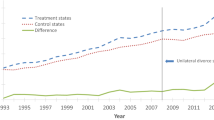Abstract
Currently, the divorce literature has mainly focused on the introduction of no-fault and unilateral divorce grounds to explain the positive relation between ‘making divorce easier’ and divorce rates. We use the case study of Belgium to demonstrate that both no-fault and unilateral might not be the ideal proxies for ‘making divorce easier’, because the procedural level of legislation is entirely disregarded. Therefore, we propose an alternative proxy which does manage to capture the time-varying legislative environment, namely the duration of the legal divorce process. We find that a reduction in the duration of the divorce process by a month increases the divorce trend with about 1.4 %.


Similar content being viewed by others
Notes
A nice overview of the no-fault debate can be found in Mechoulan (2005).
For an extensive overview, see Verschelden (2010).
A minor legal reform did take place in July 1962. This change, however, only dealt with very specific cases and is therefore of no importance to this paper.
See De Busschere (1990) for a detailed overview.
All data used were gathered from EUROSTAT, unless explicitly mentioned otherwise.
Purchasing power parity converted GDP per capita at current prices for Belgium was obtained from Alan Heston, Robert Summers and Bettina Aten, Penn World Table Version 7.0, Center for International Comparisons of Production, Income and Prices at the University of Pennsylvania, May 2011.
Estimations using DOLS to control for serial correlation in the cointegrating vectors yielded similar results and are available on request.
As mentioned supra, in the US literature the matter of classification of States was one of the main issues in the Peters-Allen-Friedberg discussion.
Ideally, one would like to include more detailed information on the introduction of computerization or other measures that increase the efficiency of courts to isolate the influence of these measures on the duration of the divorce process more adequately. Also, increased computerization may allow for do-it-yourself divorces, which could substantially reduce the (time) cost of divorce. Unfortunately, these micro-data are rarely available since courts are very reluctant to provide information regarding their internal efficiency.
References
Allen, D. W. (1992). Marriage and divorce: Comment. American Economic Review, 82(3), 679–685.
Bastaits, K., Van Peer, C., Alofs, E., Pasteels, I., & Mortelmans, D. (2011). Hoe Verloopt een Echtscheiding in Vlaanderen? In D. Mortelmans, I. Pasteels, P. Bracke, K. Matthijs, J. Van Bavel, & C. Van Peer (Eds.), Scheiding in Vlaanderen, Chap. 4 (pp. 85–112). Leuven: ACCO.
Bastaits, K., Van Peer, C., & Mortelmans, D. (2011b). Hoe Beleven Partners en Kinderen een Echtscheiding? In D. Mortelmans, I. Pasteels, P. Bracke, K. Matthijs, J. Van Bavel, & C. Van Peer (Eds.), Scheiding in Vlaanderen, Chap. 5 (pp. 113–134). Leuven: ACCO.
Binner, J. M., & Dnes, A. W. (2001). Marriage, divorce, and legal change: New evidence from England and Wales. Economic Inquiry, 39(2), 298–306.
Coelho, C., & Garoupa, N. (2006). Do divorce law reforms matter for divorce rates? Evidence from Portugal. Journal of Empirical Legal Studies, 3(3), 525–542.
De Busschere, C. (1990). De Echtscheiding op Grond van Feitelijke Scheiding. In P. Senaeve (Ed.), Echtscheiding (pp. 73–161). Leuven: ACCO.
Djankov, S., La Porta, R., Lopez-de Silanes, F., & Schleifer, A. (2003). Courts. Quarterly Journal of Economics, 118(2), 453–517.
Fella, G., Manzini, P., & Mariotti, M. (2004). Does divorce law matter? Journal of the European Economic Association, 2(4), 607–634.
Friedberg, L. (1998). Did unilateral divorce raise divorce rates? Evidence from panel data. American Economic Review, 88(3), 608–627.
Gerlo, J. (2003). Personen- en Familierecht. In Handboek voor Familierecht. Brugge: die Keure.
Gonzalez, L., & Viitanen, T. K. (2009). The effect of divorce laws on divorce rates in Europe. European Economic Review, 53(2), 127.
Gruber, J. (2004). Is making divorce easier bad for children? The long-run implications of unilateral divorce. Journal of Labor Economics, 22(4), 799–833.
Kneip, T., & Bauer, G. (2009). Did unilateral divorce laws raise divorce rates in Western Europe? Journal of Marriage and Family, 71(3), 592–607.
MacKinnon, J. (2010). Critical values for cointegration tests. Queen’s Economics Department Working Paper No. 1227
Mechoulan, S. (2005). Economic theory’s stance on no-fault divorce. Review of Economics of the Household, 3(3), 337–359.
Murray, M. P. (1994). A drunk and her dog: An illustration of cointegration and error correction. The American Statistician, 48(1), 37–39.
Peters, H. E. (1986). Marriage and divorce: Informational constraints and private contracting. American Economic Review, 76(3), 437–455.
Peters, H. E. (1992). Marriage and divorce: Reply. American Economic Review, 82(3), 686–693.
Posner, R. A. (1993). What do judges and justices maximize? (The same thing everybody else does). Supreme Court Economic Review, 3, 1–41.
Rasul, I. (2006). Marriage markets and divorce laws. Journal of Law, Economics and Organization, 22, 30–69.
Senaeve, P. (1983). Echtscheiding op Grond van Vijf Jaar Feitelijk Scheiding: De Wet van 2 December 1982. Rechtskundig Weekblad, 23, 1489–1498.
Verschelden, G. (2010). Handboek Belgisch Familierecht. Brugge: die Keure.
Wolfers, J. (2006). Did unilateral divorce laws raise divorce rates? A reconciliation and new results. American Economic Review, 96(5), 1802–1820.
Acknowledgments
We would like to thank Ben Depoorter, Gerrit De Geest, Gerdie Everaert, Mark Hoekstra, Koen Schoors, Dirk Van de gaer, Joost Vandenbossche, Marijn Verschelde, Gerd Verschelden, the participants of the Seminar Series at Ghent University and the 10th European Divorce Research Conference in Helsinki and an anonymous referee for useful comments. Financial support of the FWO and the Hercules Foundation (AUGE/11/13) is gratefully acknowledged.
Author information
Authors and Affiliations
Corresponding author
Appendix: Dickey–Fuller simulated critical values applicable to the sample
Appendix: Dickey–Fuller simulated critical values applicable to the sample
See Table 6.
Rights and permissions
About this article
Cite this article
Bracke, S., Mulier, K. Making divorce easier: the role of no-fault and unilateral revisited. Eur J Law Econ 43, 239–254 (2017). https://doi.org/10.1007/s10657-015-9485-0
Published:
Issue Date:
DOI: https://doi.org/10.1007/s10657-015-9485-0




